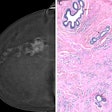With radiation exposure becoming a public issue in the U.S., the Food and Drug Administration is developing regulations that will require dosage monitoring displays on all new imaging scanners that emit ionizing radiation.
The issue has been brewing for years, but finally caught the attention of the mass media following an article in the February issue of the American Journal of Roentgenology. The article charged that some hospitals fail to adjust CT scanners for the smaller bodies of children. In the aftermath of the article, some parents have refused to allow their children to be scanned.
Now the FDA, through its Technical Electronic Product Radiation Safety Standards Committee, which met last week in Rockville, MD, is looking at ways to add dosage displays to new scanners.
"What is happening is that as the practice of medicine’s dependence on imaging increases, which it is, the overall population’s [radiation] dose is going up, [and] so the motivation is to track it," said committee member Dr. Victoria Marx, an interventional radiologist and associate professor of radiology at the University of Southern California in Los Angeles.
Overexposure to radiation during long fluoroscopy procedures such as angiography has caused burns on patients as well as equipment operators. Filmless digital technology heightens the risk even more, said Tom Shope, Ph.D., associate director in the FDA’s Office of Science and Technology.
"Normally, with x-ray film screening, overexposure gives black images that (cannot be interpreted)," Shope said. "There is a narrow range for usable film, but the new digital technology is filmless, has much wider dynamic range, and is more forgiving in producing usable images. Although it’s designed to be similar to film exposures, will proper exposure continue or will it creep up? Because of greater contrast, images will appear to look better."
With traditional images, film can be wasted if multiple pictures are taken, according to Orhan Suleiman, Ph.D., executive secretary to the committee and a Radiology Programs Branch chief in the FDA’s Center for Devices and Radiological Health. With soft-copy pictures, that’s not the case, however.
"Digital is more user-friendly, so there is a tendency to take more x-ray images," Suleiman said.
When radiation dosage became a controversy in mammography, it led to the establishment of the Mammography Quality Standards Act, a program started by the American College of Radiology and now administered by the FDA.
The state of New Jersey, recognizing that questions of radiation dosage and image quality will eventually be raised in all modalities, is installing a quality assurance program that applies to all facilities (other than mammography or dentistry) that use ionizing radiation procedures. That state has worked closely with the FDA in developing its standards.
John Sandrik, Ph.D., an imaging physicist at GE Medical Systems of Waukesha, WI, and a member of the committee, said the issue is not whether or how difficult it would be to provide some sort of dose display, but what the display is supposed to do.
"There are available devices called exposure area products that can be put on the end of an x-ray port," Sandrik said. "It gives some measure of how much radiation output is going to the patient, but if you are doing fluoroscopy in an upper GI [exam] and are panning, you have no idea of how much radiation is being delivered and in what place."
It won't be too difficult to provide a dosage display on new equipment, Sandrik said, but the complication arises when trying to calculate what organ gets what dose. Most standards are based on phantom imaging, and thus have little application to complex and varied human anatomy.
"If you want it somewhat accurate, it’s complicated," he said. "If you want it somewhat less accurate, it’s less complicated. You can calculate organ dose, but there is no consensus to what it means. We have to see what [the FDA] really wants before I can tell you how easy or difficult it would be."
The New Jersey program requires facilities to buy dosimeters and calibrate their scanners, but because the FDA regulates only equipment, not quality assurance, the committee is asking the agency to look at the feasibility of implementing requirements for dosage displays to be installed on all new equipment. The instruments are already required on most European equipment.
The FDA has been developing exposure standards for fluoroscopy for several years, and expects to finally publish regulations later this year. As with the MQSA, the U.S. government is working closely with the Reston, VA-based American College of Radiology to develop standards for CT, DR, CR, and x-ray radiation dosages.
USC's Marx said she believes there will eventually be new dosage standards for CT and DR equipment that will allow pre-exposure dose calculations and actual post-exposure measurements, because the technology already exists and is in place in the European Union.
"The whole process is lengthy, but the issue is not controversial," she said. "However, there is an economic impact and it could take several years. It will take time and the development of quality assurance programs to change people’s habits."
By Robert Bruce
AuntMinnie.com contributing writer
May 22, 2001
Related Reading
FDA worried about radiation risk from whole-body CT for routine screening, May 18, 2001
Study sparks fears over kids’ exposure to CT radiation, February 13, 2001
Click here to post your comments about this story. Please include the headline of the article in your message.
Copyright © 2001 AuntMinnie.com



















